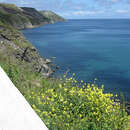tr
kırıntılardaki isimler


Planhigyn blodeuol bychan yw Bresychen ynys wair sy'n enw benywaidd. Mae'n perthyn i'r teulu Brassicaceae. Yr enw gwyddonol (Lladin) yw Coincya wrightii a'r enw Saesneg yw Lundy cabbage.[1] Ceir enwau Cymraeg eraill ar y planhigyn hwn gan gynnwys Berwr Lundy.
Mae'r dail ar ffurf 'roset' a chaiff y planhigyn ei flodeuo gan wenyn.
Planhigyn blodeuol bychan yw Bresychen ynys wair sy'n enw benywaidd. Mae'n perthyn i'r teulu Brassicaceae. Yr enw gwyddonol (Lladin) yw Coincya wrightii a'r enw Saesneg yw Lundy cabbage. Ceir enwau Cymraeg eraill ar y planhigyn hwn gan gynnwys Berwr Lundy.
Mae'r dail ar ffurf 'roset' a chaiff y planhigyn ei flodeuo gan wenyn.
Coincya wrightii, known as Lundy cabbage,[1] is a species of primitive brassicoid, endemic to the island of Lundy off the southwestern coast of England, where it is sufficiently isolated to have formed its own species, with its endemic insect pollinators. Coincya wrightii grows natively only on the eastern cliffs and slopes of the island and nowhere else in the world and is a protected species. It reaches up to a metre in height and with its yellow flowers (seen from May to August) it looks a little similar to oil seed rape. Although it is a member of the cabbage family, it tastes unpleasant – it has been described as "triple-distilled essence of Brussels sprout".
The Lundy cabbage is unique in that two species of beetles that feed on it – the Lundy cabbage flea beetle (Psylliodes luridipennis) and the Lundy cabbage weevil (Ceutorhynchus contractus pallipes) – also occur nowhere else in the world. The number of Lundy cabbages varies from year to year. Grazing by goats, sheep and rabbits is a problem, along with suppression by the invasive alien Rhododendron bushes that have been spreading across the island.
It is an excellent example of isolation on an island leading to the production of unique species.
 Lundy cabbage growing at Bristol Zoo, England
Lundy cabbage growing at Bristol Zoo, England Coincya wrightii, known as Lundy cabbage, is a species of primitive brassicoid, endemic to the island of Lundy off the southwestern coast of England, where it is sufficiently isolated to have formed its own species, with its endemic insect pollinators. Coincya wrightii grows natively only on the eastern cliffs and slopes of the island and nowhere else in the world and is a protected species. It reaches up to a metre in height and with its yellow flowers (seen from May to August) it looks a little similar to oil seed rape. Although it is a member of the cabbage family, it tastes unpleasant – it has been described as "triple-distilled essence of Brussels sprout".
The Lundy cabbage is unique in that two species of beetles that feed on it – the Lundy cabbage flea beetle (Psylliodes luridipennis) and the Lundy cabbage weevil (Ceutorhynchus contractus pallipes) – also occur nowhere else in the world. The number of Lundy cabbages varies from year to year. Grazing by goats, sheep and rabbits is a problem, along with suppression by the invasive alien Rhododendron bushes that have been spreading across the island.
It is an excellent example of isolation on an island leading to the production of unique species.
Coincya wrightii là một loài thực vật có hoa trong họ Cải. Loài này được (O.E.Schultz) Stace mô tả khoa học đầu tiên năm 1989.[1]
Coincya wrightii là một loài thực vật có hoa trong họ Cải. Loài này được (O.E.Schultz) Stace mô tả khoa học đầu tiên năm 1989.
Coincya wrightii (O.E.Schulz) Stace, 1989
Coincya wrightii (лат.) — вид двудольных растений рода Coincya семейства Капустные (Brassicaceae). Под текущим таксономическим названием был описан британским ботаником Клайвом Энтони Стэйсом в 1989 году[2][3].
Распространённое англоязычное название — «Lundy cabbage»[4].
Эндемик Англии (Великобритания), в дикой природе встречающийся исключительно на острове Ланди[4][5]. Предполагается, что до наступления последнего ледникового периода, окончившегося около 9 тыс. лет назад, ареал растения мог быть шире. Предпочитает скалистые участки[6].
Примитивный вид[5], вследствие изолированности от других земель сохранивший, как отмечается, уникальные черты строения и жизненного цикла. Растение внушительных размеров, высотой до 150 см. Листорасположение розеточное. Цветки жёлтые. Цветёт с мая по июль, плодоносит в конце лета и осенью[6].
Является растением-хозяином для двух местных видов мелких насекомых — Psylliodes luridipennis и Ceutorhynchus contractus var. pallipes[6].
Редкое растение, требующее значительных мер по сохранению своего ареала. Особенную угрозу виду представляют, в частности, завезённые на остров Ланди в XIX веке в качестве декоративных растений рододендроны, с которыми Coincya wrightii не выдерживает конкуренции. Двум вышеозначенным видам насекомых, ассоциированных с этим растением, также может угрожать исчезновение в случае уменьшения его популяции[6].
Синонимичные названия[2]:
Coincya wrightii (лат.) — вид двудольных растений рода Coincya семейства Капустные (Brassicaceae). Под текущим таксономическим названием был описан британским ботаником Клайвом Энтони Стэйсом в 1989 году.
Распространённое англоязычное название — «Lundy cabbage».